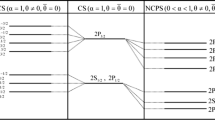Abstract
In this work we calculate the correction to the ground state energy of the hydrogen atom due to contributions arising from the presence of a minimal length. The minimal-length scenario is introduced by means of modifying the Dirac equation through a deformed Heisenberg algebra (Kempf algebra). With the introduction of the Coulomb potential in the new Dirac energy operator, we calculate the energy shift of the ground state of the hydrogen atom in first order of the parameter related to the minimal length via perturbation theory.
Similar content being viewed by others
Notes
We use boldface to a vector operator for a sake of simplicity.
There is a summation over dummy indices.
We use “ordinary quantum mechanics” in opposition to quantum mechanics in a minimal-length scenario.
α and \(\hat{\beta}\) must be not confused with the fine structure constant α and the minimal-length parameter β.
Note that x i is not eigenvalue of the \(\hat{X}_{i}\) operator. In fact, the existence of the minimal length implies that \(\hat{X}_{i}\) operator cannot have any eigenstate which is a physical sate, that is, any eigenfunction within the Hilbert space [5, 26]. Nevertheless, the “position” representation is particularly useful when the shifts in the energy can be calculate via perturbation theory in X-space [9].
References
H. Kragh, Heisenberg’s lattice world: the 1930 theory sketch. Am. J. Phys. 63, 595 (1995)
W. Heisenberg, Über die in der Theorie der Elementarteilchen auftretende universelle Länge. Ann. Phys. 424, 20 (1938)
H.S. Snyder, Quantized space-time. Phys. Rev. 71(1), 38 (1947)
S. Majid, H. Ruegg, Bicrossproduct structure of κ-Poincaré group and non-commutative geometry. Phys. Lett. B 334, 348 (1994)
A. Kempf, G. Mangano, R.B. Mann, Hilbert space representation of the minimal length uncertainty relation. Phys. Rev. D 52, 1108 (1995)
M. Bronstein, Quantum theory of weak gravitational fields. Gen. Relativ. Gravit. 44, 267 (2012) (republication)
C.A. Mead, Possible connection between gravitation and fundamental length. Phys. Rev. 135, B849 (1964)
C.A. Mead, F. Wilczek, Walking the Planck length through history. Phys. Today 54, 15 (2001)
L.N. Chang, Z. Lewis, D. Minic, T. Takeuchi, On the minimal length uncertainty relation and the foundations of string theory. Adv. High Energy Phys. 2011, 493514 (2011)
M. Sprenger, P. Nicolini, M. Bleicher, Physics on the smallest scales: an introduction to minimal length phenomenology. Eur. J. Phys. 33, 853 (2012)
S. Hossenfelder, Minimal length scale scenarios for quantum gravity. Living Rev. Relativ. 16, 2 (2013)
S. Hossenfelder, A note on theories with a minimal length. Class. Quantum Gravity 23, 1815 (2006)
A. Kempf, Non-pointlike particles in harmonic oscillators. J. Phys. A 30, 2093 (1997)
L.G. Suttorp, S.R. De Groot, Covariant equations of motion, for a charged particle with a magnetic dipole moment. Nuovo Cimento A 65, 245 (1970)
E.A. De Kerf, G.G.A. Bäuerle, A position operator for a relativistic particle with spin. Physica 57, 121 (1972)
N. Arkani-Hamed, S. Dimopoulos, G. Dvali, The hierarchy problem and new dimensions at a millimeter. Phys. Lett. B 429, 263 (1998)
T. Appelquist, H.C. Cheng, B.S. Dobrescu, Bounds on universal extra dimensions. Phys. Rev. D 64, 035002 (2001)
S. Hossenfelder, M. Bleicher, S. Hofmann, J. Ruppert, S. Scherer, H. Stöcker, Signatures in Planck regime. Phys. Lett. B 575, 85 (2003)
F. Brau, Minimal length uncertainty relation and hydrogen atom. J. Phys. A 32, 7691 (1999)
R. Akhoury, Y.P. Yao, Minimal length uncertainty relation and the hydrogen spectrum. Phys. Lett. B 572, 37 (2003)
S. Benczik, L.N. Chang, D. Minic, T. Takeuchi, Hydrogen-atom spectrum under a minimal-length hypothesis. Phys. Rev. A 72, 012104 (2005)
K. Nouicer, Coulomb potential in one dimension with minimal length: a path integral approach. J. Math. Phys. 48, 112104 (2007)
D. Bouaziz, N. Ferkous, Hydrogen atom in momentum space with a minimal length. Phys. Rev. A 82, 022105 (2010)
M.I. Samar, Modified perturbation theory for hydrogen atom in space with Lorentz-covariant deformed algebra with a minimal length. J. Phys. Stud. 15(1), 1007 (2011)
A. Kempf, G. Mangano, Minimal length uncertainty relation and ultraviolet regularization. Phys. Rev. D 55, 7909 (1997)
G.C. Dorsch, J.A. Nogueira, Maximally localized states in quantum mechanics with modified commutation relation to all orders. Int. J. Mod. Phys. A 27, 1250113 (2012)
C.G. Parthey et al., Improved measurement of the hydrogen 1S–2S transition frequency. Phys. Rev. Lett. 107, 203001 (2011)
E. Merzbacher, Quantum Mechanics (Wiley, New York, 1970), p. 672
Acknowledgements
We would like to thank CAPES, CNPq and FAPES (Brazil) for financial support.
Author information
Authors and Affiliations
Corresponding author
Appendices
Appendix A: Relativistic energy of the electron
From Eq. (18) we have a linear homogeneous system of equations for ϕ and χ,
which has non-trivial solution only for
Thus, after throwing away terms of order β 2, the relativistic energy of the free electron in the regarded scenario of minimal length can be obtained from
as was expected from \(E^{2}_{ML} = c^{2}P^{2} + m^{2}c^{4}\).
Appendix B: Corrections in the first order of perturbation
In order to obtain
where ϕ and χ are two-component eigenspinors of the state,
\(Y^{j, m}_{j \pm1/2} (\theta, \phi ) \) are the common eigenspinor-function of \(\hat{j}_{z}\) and \(\hat{J}^{2}\) and
where
and
we employ the following identity [28]:
with
After some algebra we get
and
and
Finally,
2.1 B.1 Ground state energy
For the ground state we have \(j = \frac{1}{2}\) and n′=0, then
where
with \(\epsilon= \sqrt{1- \alpha^{2}}\).
Hence
where E 0=mc 2 ϵ is the energy of the |ψ 0〉 ground state of the hydrogen atom obtained from the ordinary Dirac equation.
Rights and permissions
About this article
Cite this article
Antonacci Oakes, T.L., Francisco, R.O., Fabris, J.C. et al. Ground state of the hydrogen atom via Dirac equation in a minimal-length scenario. Eur. Phys. J. C 73, 2495 (2013). https://doi.org/10.1140/epjc/s10052-013-2495-6
Received:
Revised:
Published:
DOI: https://doi.org/10.1140/epjc/s10052-013-2495-6




